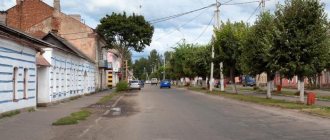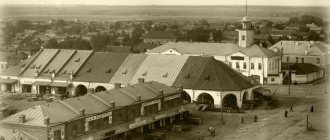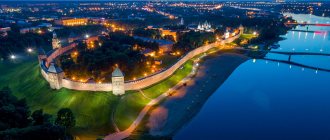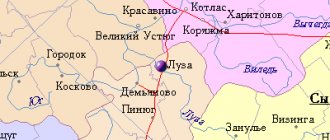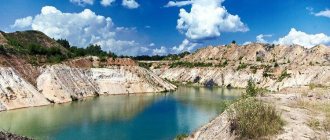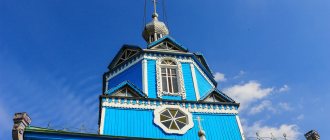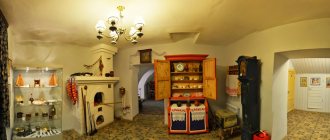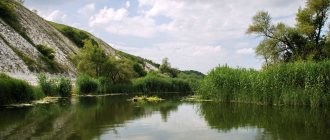This term has other meanings, see Hill (meanings).
| City Hill Coat of arms |
| A country | Russia, Russia |
| Subject of the federation | Novgorod regionNovgorod region |
| Municipal district | Kholmsky |
| urban settlement | Kholmskoe |
| Coordinates | 57°09′00″ n. w. 31°11′00″ E. d. / 57.15000° n. w. 31.18333° E. d. / 57.15000; 31.18333 (G) [www.openstreetmap.org/?mlat=57.15000&mlon=31.18333&zoom=12 (O)] (Z)Coordinates: 57°09′00″ N. w. 31°11′00″ E. d. / 57.15000° n. w. 31.18333° E. d. / 57.15000; 31.18333 (G) [www.openstreetmap.org/?mlat=57.15000&mlon=31.18333&zoom=12 (O)] (I) |
| Head of a city settlement | Salyaev Vitaly Ilyich |
| First mention | 1144 |
| City with | 1777 |
| Square | 9 km² |
| Center height | 65 |
| Population | ↘3493[1] people (2016) |
| Density | 388.11 people/km² |
| Timezone | UTC+3 |
| Telephone code | +7 81654 |
| Postal codes | 175270, 175271 |
| Vehicle code | 53 |
| OKATO code | [classif.spb.ru/classificators/view/okt.php?st=A&kr=1&kod=49247501 49 247 501] |
| Hill Moscow |
| Velikiy Novgorod Hill |
| Hill |
Audio, photo and video
on Wikimedia Commons
Hill
- a city (since 1777[2]) in Russia, the administrative center of the Kholm municipal district of the Novgorod region.
General information
Located in the south of the region at the confluence of the Kunya River with Lovat (Lake Ilmen basin), 201 km south of Veliky Novgorod.
There are three roads leading from the city: one ( P51
) through Poddorye connects Kholm with Staraya Russa, another (
P51
) through the village of Loknya in the Pskov region connects it with Velikiye Luki, the third leads to Marevo and Demyansk.
The population of the city is 3829 inhabitants (as of January 1, 2010). The etymology of the name is Russian, coming from the steep hill on the right bank of the Lovat, on which the city was founded.
Story
In ancient times, a water trade route from the Varangians to the Greeks passed along the Lovat River through the territory of the modern city. In those days, small ships were built in this place, flax, carts, spinning wheels, and dishes (wooden and clay) were traded.
In the 16th-17th centuries it was repeatedly attacked by Lithuanians, Poles, and Swedes[3]. On August 3, 1777, when considering the issue of reorganizing the administrative-territorial division of the Novgorod province, a Decree was issued to rename the Kholmsky settlement into the city of Kholm and to include it in the Pskov province. So Kholm became the center of Kholm district.
At the end of the 19th century, the Hill was famous for its handicrafts, including the making of river barges and other boats.
The city suffered greatly during the Great Patriotic War: in 1942 it was the site of the Toropetsko-Kholm operation, and most of the city’s historical buildings were completely destroyed.
Historically, the city consisted of four districts - Ilyinsky
and
Nikolsky
(right bank of Kunya and Lovat),
Tatilovsky
(left bank of Lovat) and
Klinsky
(wedge between the rivers). After the war, the restoration of the Klin part of the city was considered inappropriate.
There is a curious error associated with the history of the city of Holm. In a number of books and articles, the date of the first mention of the city in chronicle sources is 1144 (from which it was proposed to trace the history of the city)[2]. In this case, the Novgorod first chronicle was implied; however, under this year it contains a record of a fire in Novgorod as a result of which Kholm
(part of the city) and the Church of the Prophet Elijah.
Social characteristics
The district's economy employs 2,500 people, which is 40.6% of the total population. The average unemployment rate is 0.8%.
The average monthly nominal wage of employees of large and medium-sized organizations (excluding small businesses) for 9 months of 2012 in the region amounted to 14,257.4 rubles, including for certain types of economic activity:
- Agriculture, hunting and forestry: 13939.40 rubles.
- Production and distribution of electricity, gas and water: 9995.60 rubles.
- Wholesale and retail trade; repair of vehicles, motorcycles, household products and personal items: 14,817.60 rubles.
- Hotels and restaurants: 11858.80 rubles.
- Transport and communications: 9100.00 rubles.
- Operations with real estate, rent and provision of services: 13,050.00 rubles.
- Public administration and military security; compulsory social security: 18828.50 rubles.
- Education: 14310.10 rubles.
- Healthcare and social services: 13,392.30 rubles.
- Provision of other communal, social and personal services: 11,091.90 rubles.
Medical care for the population of the district is provided by the state regional budgetary healthcare institution “Kholm Central District Hospital”, which includes a hospital with 32 beds, a clinic, a children’s consultation, a dental department, an emergency medical service station, and 6 paramedic-midwife stations. There is a pharmacy in Kholm.
There are 29 cultural institutions in the area, including: a municipal museum, 15 libraries, 12 cultural and leisure institutions, and a children's art school.
There is a social institution in the area, the Kholm Center for Social Assistance to Family and Children.
There are 4 general educational institutions, of which one secondary (complete) comprehensive school (in the city of Kholm), two basic secondary schools (the villages of Morkhovo and the village of Togod), one elementary school-kindergarten (the village of Krasny Bor), 5 kindergartens , municipal center of further education. There is a boarding school at the Kholm school. Students are transported to all schools by school buses.
Attractions
30 kilometers from the city on Lake Rdeiskoye are the remains of the Rdeiskoye Monastery (XVIII century), in the area are the former estates of the princes Bobrov (XIX century) and Shakhovsky (XVIII century).
One of the favorite vacation spots of the hill people is the Blue Lagoon. This is a natural threshold of the Mesozoic geological plate on the Big Tuder River. The place is truly amazing, and the water there has healing properties due to the occurrence of blue clays in the area. Many people who want to restore their strength visit this place in the summer, when the Blue Lagoon is available for swimming.
Notes
- ↑ 12
www.gks.ru/free_doc/doc_2016/bul_dr/mun_obr2016.rar Population of the Russian Federation by municipalities as of January 1, 2016 - ↑ 12
THE USSR. Administrative-territorial division of the union republics on January 1, 1980 / Compiled by V. A. Dudarev, N. A. Evseeva. - M.: Publishing house "Izvestia of the Soviets of People's Deputies of the USSR", 1980. - 702 p. — P. 180. - Kholm, district town of Pskov province // Encyclopedic Dictionary of Brockhaus and Efron: in 86 volumes (82 volumes and 4 additional). - St. Petersburg, 1890-1907.
- Statistical image of cities and towns of the Russian Empire until 1825. Comp. from the official information under the direction of the Director of the Police Department, Executive Stehr. St. Petersburg, 1829.
- Review of the state of the cities of the Russian Empire in 1833 / Ed. at the Ministry of Internal Affairs. - St. Petersburg, 1834.
- Statistical tables on the state of cities of the Russian Empire. Comp. in Stat. dept. Council of the Ministry of Internal Affairs. - St. Petersburg, 1840.
- Statistical tables of the Russian Empire, compiled and published by order of the Minister of Internal Affairs Stat. department of the Central Statistical Committee. [Vol. 1]. For the year 1856. St. Petersburg, 1858.
- Statistical timebook of the Russian Empire. Series 1. Vol. 1. St. Petersburg, 1866.
- Statistical timebook of the Russian Empire. Series 2. Vol. 1. - St. Petersburg, 1871, p. 180.
- Statistical timebook of the Russian Empire. Series 2. Vol. 10. St. Petersburg, 1875, p. 98.
- Statistics of the Russian Empire. 1: Collection of information on Russia for 1884-1885. St. Petersburg, 1887, p. 24.
- demoscope.ru/weekly/ssp/rus_gub_97.php?reg=34
- ↑ 1234
Cities of the USSR / NKVD of the RSFSR, Stat. Department. - M., 1927 - ↑ 12345678910111213
[www.MojGorod.ru/novgorod_obl/holm/index.html People's encyclopedia “My City”. Hill (city)]. Retrieved June 17, 2014. [www.webcitation.org6QOerqQU8/ Archived from the original on June 17, 2014]. - All-Union Population Census of 1926 = Recensement de la population de L'URSS 1926 / Central Statistical Office of the USSR; Dept. census. T.2. Western region. Central Industrial Region: nationality, native language, age, literacy. - M.: Publishing house. Central Statistical Office of the USSR, 1928
- RGAE, f. 1562, op. 336, no. 1248, pp. 49-57.
- [demoscope.ru/weekly/ssp/rus59_reg2.php All-Union Population Census of 1959. The size of the urban population of the RSFSR, its territorial units, urban settlements and urban areas by gender] (Russian). Demoscope Weekly. Retrieved September 25, 2013. [www.webcitation.org/6GDOghWC9 Archived from the original on April 28, 2013].
- [demoscope.ru/weekly/ssp/rus70_reg2.php All-Union Population Census of 1970 The size of the urban population of the RSFSR, its territorial units, urban settlements and urban areas by gender.] (Russian). Demoscope Weekly. Retrieved September 25, 2013. [www.webcitation.org/6GDOiMstp Archived from the original on April 28, 2013].
- [demoscope.ru/weekly/ssp/rus79_reg2.php All-Union Population Census of 1979 The size of the urban population of the RSFSR, its territorial units, urban settlements and urban areas by gender.] (Russian). Demoscope Weekly. Retrieved September 25, 2013. [www.webcitation.org/6GDOjhZ5L Archived from the original on April 28, 2013].
- [demoscope.ru/weekly/ssp/rus89_reg2.php All-Union Population Census of 1989. Urban population]. [www.webcitation.org/617x0o0Pa Archived from the original on August 22, 2011].
- [www.perepis2002.ru/ct/doc/1_TOM_01_04.xls All-Russian Population Census 2002. Volume. 1, table 4. Population of Russia, federal districts, constituent entities of the Russian Federation, districts, urban settlements, rural settlements - regional centers and rural settlements with a population of 3 thousand or more]. [www.webcitation.org/65AdCU0q3 Archived from the original on February 3, 2012].
- [www.gks.ru/bgd/regl/B09_109/IssWWW.exe/Stg/d01/tabl-21-09.xls Number of permanent population of the Russian Federation by cities, urban-type settlements and districts as of January 1, 2009]. Retrieved January 2, 2014. [www.webcitation.org/6MJmu0z1u Archived from the original on January 2, 2014].
- [novgorodstat.gks.ru/wps/wcm/connect/rosstat_ts/novgorodstat/resources/b00dff804edfeae3a933a93467c8ff84/Table+12.pdf All-Russian Population Census 2010. 12. Population of municipal districts, settlements, urban and rural settlements of the Novgorod region]. Retrieved February 2, 2014. [www.webcitation.org/6N5OGNTw6 Archived from the original on February 2, 2014].
- [www.gks.ru/free_doc/doc_2012/bul_dr/mun_obr2012.rar Population of the Russian Federation by municipalities. Table 35. Estimated resident population as of January 1, 2012]. Retrieved May 31, 2014. [www.webcitation.org/6PyOWbdMc Archived from the original on May 31, 2014].
- [www.gks.ru/free_doc/doc_2013/bul_dr/mun_obr2013.rar Population of the Russian Federation by municipalities as of January 1, 2013. - M.: Federal State Statistics Service Rosstat, 2013. - 528 p. (Table 33. Population of urban districts, municipal districts, urban and rural settlements, urban settlements, rural settlements)]. Retrieved November 16, 2013. [www.webcitation.org/6LAdCWSxH Archived from the original on November 16, 2013].
- [www.gks.ru/free_doc/doc_2014/bul_dr/mun_obr2014.rar Table 33. Population of the Russian Federation by municipalities as of January 1, 2014]. Retrieved August 2, 2014. [www.webcitation.org/6RWqP50QK Archived from the original on August 2, 2014].
- [www.gks.ru/free_doc/doc_2015/bul_dr/mun_obr2015.rar Population of the Russian Federation by municipalities as of January 1, 2015]. Retrieved August 6, 2015. [www.webcitation.org/6aaNzOlFO Archived from the original on August 6, 2015].
- taking into account the cities of Crimea
- [www.gks.ru/free_doc/doc_2016/bul_dr/mun_obr2016.rar Population of the Russian Federation by municipalities as of January 1, 2016. Table “31. Population of cities and towns by federal districts and constituent entities of the Russian Federation as of January 1, 2016.” RAR archive (1.0 MB)]
- Temmo A. M., Vyazinin I. N.
Golden stars of Novgorodians. - L.: Lenizdat, 1987. - 272 p. — P. 57.
Economic and investment potential
Economic potential
Kholmsky district belongs to the peripheral regions of the Novgorod region. The area is agricultural, mostly poorly developed.
Industry in the region is represented by 9 enterprises engaged in logging and wood processing. In the structure of industrial products, wood processing accounts for 85%.
The main ones:
LLC "Auction" 175270, Novgorod region, Kholm, st. Kooperativnaya, 27z. Phone: (81654) 51-669. Director: Vitaly Vladimirovich Ivanov. Woodworking, lumber production.
LLC "Holm Lesprom" 175271, Novgorod region, Kholm, st. A. Movchan, 2. General Director: Kulichkin Sergey Nikolaevich. Logging, wood processing.
LLC "Kholm Timber Trading Company" 175270, Novgorod region, Kholm, st. Kooperativnaya, 27v. Phone: (81654) 51-303. Director: Makke Nikolai Petrovich. Logging, wood processing, birch veneer logs, pulpwood, sawlogs.
LLC "Sigma - Kholm" 175271, Novgorod region, Kholm, st. Starorusskaya, 55. Telephone: (81654) 51-207. General Director: Pavlov Vladimir Leontievich. Logging, wood processing, birch veneer logs, pulpwood, sawlogs.
LLC "LesDorStroy" 175270, Novgorod region, Kholm, st. Kooperativnaya, 27v. Phone: (81654) 51-303. Director: Makke Nikolai Petrovich. Providing services in the field of logging.
LLC "Kholmtekhles" 174291, Novgorod region, Kholmsky district, Chekunovo village, st. Central, 22. Phone: (81654) 51-321. General Director: Nikitin Alexander Ivanovich. Logging, wood processing, birch veneer logs, pulpwood.
At the beginning of 2012, 26 small enterprises and 150 individual entrepreneurs were registered in the district.
There are no agricultural enterprises in the region.
Agricultural production in the region is carried out by 12 peasant (farm) farms, employing 49 people, 13 individual entrepreneurs and 3,152 personal subsidiary plots.
There are 22,217 hectares of farmland in the area, including 10,428 hectares of arable land, 6,117 hectares of hayfields, and 5,672 hectares of pastures. The percentage of arable land use in 2012 was 10.52%. arable land.
Trade services to the population of the region are provided in 67 retail outlets. The total area of retail outlets is 5761.7 sq.m., retail – 3383.4 sq.m. In the area there is one canteen with 40 seats and 3 cafes with 98 seats.
Investment potential
The advantages of the Kholmsky district are:
- ecological cleanliness of the area and favorable natural conditions;
- presence of mineral reserves and large forest lands;
- availability of free and partially occupied production space;
- leasing, selling unused production space, land plots, and other municipal property to business structures;
- equal conditions of competition for all business structures operating in the district;
The strengths of the municipal district include:
- location of the area on the border with the Pskov and Tver regions;
- passing through the territory of the Shimsk-Staraya Russa-Nevel highway;
- the presence of deposits of raw materials for the production of building materials (clay, sand), fresh water reserves, water bodies;
- favorable environmental conditions;
- availability of unclaimed land resources.
- availability of areas suitable for residential development;
- availability of resources for tourism development in the region;
- availability of potentially free labor.
- low crime rate.
The area's weaknesses include:
- lack of railway communication in the area;
- lack of prospects for gasification of the area;
- the unsatisfactory condition of the roads passing through the territory and connecting the Novgorod region with the Pskov and Tver regions;
- insufficient development of engineering infrastructure for housing construction;
- lack of qualified labor;
- single-industry industry of the region;
- the shallow contours of the lands, in some places they are very swampy and waterlogged;
- lack of developed tourist routes and tourism infrastructure.
Kholmsky district is one of the areas with the most favorable agroclimatic conditions in the Novgorod region: relatively mild and short winter, long warm growing season, moderate rainfall.
Kholmsky district belongs to an ecologically clean zone.
The city has a valuable natural landscape, formed by the picturesque steep and gentle banks of the Lovati and Kunya rivers, overgrown with trees and bushes. The influence of landscape is dominant in creating the appearance of the city. The city has a city park and a park-arboretum, founded in 1965. All this together represents aesthetic value and provides an opportunity to attract tourists to the area.
The priority areas for attracting investment are:
- forestry industry - more advanced wood processing (drying of lumber, transition from the production of lumber to the production of final products, furniture, etc.)
- mineral resources industry - development of clay and sand deposits (production of bricks, ceramics, tiles).
- tourism - development of tourism (in the area there is a hotel and vacant premises that can be reconstructed as a tourist center).
- agro-industrial complex.
- housing construction.
Infrastructure
The energy supply to the region is provided by a branch of IDGC-North-West OJSC (Novgorodenergo) through the Kholm 110/35/10 kV substation, which is connected via a 110 kV overhead line to the Pskov energy system and via a 110 overhead line to the Starorusskaya substation 330 /110/35/10.
The draft territorial planning scheme for the Novgorod region plans to:
- Completion of the begun construction of the 110 kV overhead line “110/35/10 kV Russa substation – 110/35/10 kV Poddorye substation – 110/35/10 kV Kholm substation”, with a length of 100 km. The construction of a 110 kV overhead line “110/35/10 kV Russa substation – 110/35/10 kV Poddorye substation – 110/35/10 kV Kholm substation” will make it possible in the future to transfer the existing 35 kV network between the 110/35/10 kV “Russa” substation " and "Holm", fully depreciated in terms of service life and having a low throughput, for a voltage of 110 kV;
- reconstruction of the Kholm substation 110/35/10 kV 2x10 MVA with the replacement of equipment and transformers with modern types. Reconstruction of a 110 kV outdoor switchgear with the construction of a 110 kV linear cell with an electric gas switch;
Heat supply to the district's consumers is provided by boiler houses of MP Novzhilkommunservis LLC and municipal boiler houses. The total capacity of boiler houses is 11.2 Gcal/hour.
In the territory of the district, telephone communication is provided by OJSC Rostelecom Intercity and International Electric Communications Macro-regional branch "North-West" Novgorod branch, which has an automatic telephone exchange in the territory of the district. The capacity of the automatic telephone exchange is 2162 telephone numbers, of which 1876 numbers or 86.8% are in use.
Mobile operators operating in the district are: Megafon, MTS, Beeline Telecom, TELE-2.
Literature
- Kotov V.V.
[cyberleninka.ru/article/n/skolko-let-holmu-na-lovati How old is the Hill on Lovat?] // Pskov. Scientific-practical, historical and local history journal. - 2008. - No. 28. - P. 3-7. - Kotov V.V.
[cyberleninka.ru/article/n/holmskaya-krepost-xvi-veka Kholmskaya fortress of the 16th century] // Pskov. Scientific-practical, historical and local history journal. - 2008. - No. 29. - P. 3-15. - Kotov V.V.
[cyberleninka.ru/article/n/ekskursiya-v-gorod-holm-xvi-veka Excursion to the city of Holm of the 16th century] // Pskov. Scientific-practical, historical and local history journal. - 2013. - No. 38. - P. 43-51.
An excerpt characterizing the Hill (city)
- No. “If it were true that he was defeated, then the news would come.” “Probably,” said Prince Andrei and headed towards the exit door; but at the same time, a tall, obviously visiting, Austrian general in a frock coat, with a black scarf tied around his head and with the Order of Maria Theresa around his neck, quickly entered the reception room, slamming the door. Prince Andrei stopped. - General Chief Kutuzov? - the visiting general quickly said with a sharp German accent, looking around on both sides and walking without stopping to the office door. “The general in chief is busy,” said Kozlovsky, hastily approaching the unknown general and blocking his path from the door. - How would you like to report? The unknown general looked contemptuously down at the short Kozlovsky, as if surprised that he might not be known. “The general in chief is busy,” Kozlovsky repeated calmly. The general's face frowned, his lips twitched and trembled. He took out a notebook, quickly drew something with a pencil, tore out a piece of paper, gave it to him, walked quickly to the window, threw his body on a chair and looked around at those in the room, as if asking: why are they looking at him? Then the general raised his head, craned his neck, as if intending to say something, but immediately, as if casually starting to hum to himself, he made a strange sound, which immediately stopped. The door to the office opened, and Kutuzov appeared on the threshold. The general with his head bandaged, as if running away from danger, bent down and approached Kutuzov with large, fast steps of his thin legs. “Vous voyez le malheureux Mack, [You see the unfortunate Mack.],” he said in a broken voice. The face of Kutuzov, standing in the doorway of the office, remained completely motionless for several moments. Then, like a wave, a wrinkle ran across his face, his forehead smoothed out; He bowed his head respectfully, closed his eyes, silently let Mac pass by him and closed the door behind himself. The rumor, already spread before, about the defeat of the Austrians and the surrender of the entire army at Ulm, turned out to be true. Half an hour later, adjutants were sent in different directions with orders proving that soon the Russian troops, which had hitherto been inactive, would have to meet the enemy. Prince Andrei was one of those rare officers at the headquarters who believed his main interest was in the general course of military affairs. Having seen Mack and heard the details of his death, he realized that half of the campaign was lost, understood the difficulty of the position of the Russian troops and vividly imagined what awaited the army, and the role that he would have to play in it. Involuntarily, he experienced an exciting, joyful feeling at the thought of disgracing arrogant Austria and the fact that in a week he might have to see and take part in a clash between the Russians and the French, for the first time since Suvorov. But he was afraid of the genius of Bonaparte, who could be stronger than all the courage of the Russian troops, and at the same time could not allow shame for his hero. Excited and irritated by these thoughts, Prince Andrei went to his room to write to his father, to whom he wrote every day. He met in the corridor with his roommate Nesvitsky and the joker Zherkov; They, as always, laughed at something. -Why are you so gloomy? – Nesvitsky asked, noticing the pale face of Prince Andrei with sparkling eyes. “There’s no point in having fun,” Bolkonsky answered. While Prince Andrei met with Nesvitsky and Zherkov, on the other side of the corridor, Strauch, an Austrian general who was at Kutuzov’s headquarters to monitor the food supply of the Russian army, and a member of the Gofkriegsrat, who had arrived the day before, walked towards them. There was enough space along the wide corridor for the generals to freely disperse with three officers; but Zherkov, pushing Nesvitsky away with his hand, said in a breathless voice: “They’re coming!... they’re coming!... step aside, get out of the way!” please the way! The generals passed by with an air of desire to get rid of bothersome honors. The face of the joker Zherkov suddenly expressed a stupid smile of joy, which he seemed unable to contain. “Your Excellency,” he said in German, moving forward and addressing the Austrian general. – I have the honor to congratulate you. He bowed his head and awkwardly, like children learning to dance, began to shuffle first with one foot and then with the other. The general, a member of the Gofkriegsrat, looked sternly at him; without noticing the seriousness of the stupid smile, he could not refuse a moment’s attention. He narrowed his eyes to show that he was listening. “I have the honor to congratulate you, General Mack has arrived, he’s completely healthy, he just got a little sick,” he added, beaming with a smile and pointing to his head. The general frowned, turned away and walked on. – Gott, wie naiv! [My God, how simple it is!] - he said angrily, walking away a few steps. Nesvitsky hugged Prince Andrei with laughter, but Bolkonsky, turning even paler, with an angry expression on his face, pushed him away and turned to Zherkov. The nervous irritation into which the sight of Mack, the news of his defeat and the thought of what awaited the Russian army led him, found its outcome in anger at Zherkov’s inappropriate joke. “If you, dear sir,” he spoke shrilly with a slight trembling of his lower jaw, “want to be a jester, then I cannot prevent you from doing so; but I declare to you that if you dare to make fun of me in my presence another time, then I will teach you how to behave. Nesvitsky and Zherkov were so surprised by this outburst that they silently looked at Bolkonsky with their eyes open. “Well, I just congratulated,” said Zherkov. – I’m not joking with you, please remain silent! - Bolkonsky shouted and, taking Nesvitsky by the hand, walked away from Zherkov, who could not find what to answer. “Well, what are you talking about, brother,” Nesvitsky said calmingly. - Like what? - Prince Andrei spoke, stopping from excitement. - Yes, you must understand that we are either officers who serve our tsar and fatherland and rejoice in the common success and are sad about the common failure, or we are lackeys who do not care about the master’s business. Quarante milles hommes massacres et l'ario mee de nos allies detruite, et vous trouvez la le mot pour rire,” he said, as if cementing his opinion with this French phrase. - C'est bien pour un garcon de rien, comme cet individu, dont vous avez fait un ami, mais pas pour vous, pas pour vous. [Forty thousand people died and the army allied to us was destroyed, and you can joke about it. This is forgivable for an insignificant boy like this gentleman whom you made your friend, but not for you, not for you.] Boys can only have fun like this,” said Prince Andrei in Russian, pronouncing this word with a French accent, noting that Zherkov could still hear him. He waited to see if the cornet would answer. But the cornet turned and left the corridor. The Pavlograd Hussar Regiment was stationed two miles from Braunau. The squadron, in which Nikolai Rostov served as a cadet, was located in the German village of Salzenek. The squadron commander, captain Denisov, known throughout the cavalry division under the name Vaska Denisov, was allocated the best apartment in the village. Junker Rostov, ever since he caught up with the regiment in Poland, lived with the squadron commander. On October 11, the very day when everything in the main apartment was raised to its feet by the news of Mack's defeat, at the squadron headquarters, camp life calmly went on as before. Denisov, who had lost all night at cards, had not yet come home when Rostov returned from foraging early in the morning on horseback. Rostov, in a cadet's uniform, rode up to the porch, pushed his horse, threw off his leg with a flexible, youthful gesture, stood on the stirrup, as if not wanting to part with the horse, finally jumped off and shouted to the messenger.
Contacts of persons supervising investment activities
https://www.holmadmin.net/invest.html
| Home page | Materials | Bodies of the Association |
| Events Members of the Association Legal framework Activity reports Our partners Useful links | Review of legislation Municipal practice Information publications Competitions Methodological manuals Training Municipal navigator | General meeting of members of the Association Board of the Association President of the Association Executive Director of the Association Vice-President of the Association Executive Office Audit Commission of the Association Council of Lawyers Council of Control and Accounting Bodies |
